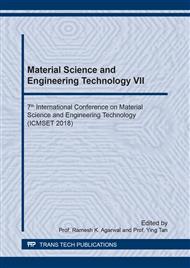p.50
p.55
p.60
p.65
p.70
p.75
p.80
p.85
p.90
Effect of GMAW Shielding Gas on Tensile Strength of Dissimilar SS400 Carbon Steel and SUS304 Stainless Steel Butt Joint
Abstract:
An optimization of a gas metal arc welding (GMAW) process parameter is currently investigated for producing a dissimilar SS400/SUS304 steels joint because a requirement of a sound joint with higher tensile strength. A gas shielding type is one of the important parameter because it could produce a good arc, protect the weld pool from atmosphere and so on. So, this research work aimed to study an effect of the shielding gas type on the mechanical properties of the dissimilar SS400/SUS304 steels butt joint. A relation between microstructure and the mechanical properties of the butt joint was also investigated and compared. The summarized results are as follows. The optimized shielding gas that produced a maximum tensile stregnth of 550 MPa was 95%Ar+5%N2. Nitrogen gas that mixed to the shielding gas affected to decrease dendrite size and to increase the hardness and tensile strength of weld metal. Fracture characteristic of the joint produced by N2 mixed gas showed a larger deformation at the location that was closely the fracture location that implied a ductile behavior. The dissimilar SUS304/SS400 metals joint showed a low hardness base metal, a higher hardness interface and a highest hardness weld metal.
Info:
Periodical:
Pages:
70-74
Citation:
Online since:
April 2019
Authors:
Keywords:
Price:
Сopyright:
© 2019 Trans Tech Publications Ltd. All Rights Reserved
Share:
Citation:


